
‘The opposition between hearing and staring finds its strange union with the diamond stylus, a diamond above all that writes out sound as well as reflects light.‘ — Duncan Smith, The Age of Oil
‘Paul DeMarinis, a pioneer of early electronic, interactive art, teaches in Stanford’s art department. He recently received the prestigious Ars Electronica Golden Nica award for his piece The Messenger. An elaborate visualization of incoming e-mail, The Messenger is based on 18th century physician Francesc Silva’s telegraph system in which 26 servants, each assigned a letter of the alphabet, would reconstruct messages from afar by announcing their letter when they received an electric shock.
‘DeMarinis’s art studio sits on the western edge of Stanford’s campus, where the trees aren’t manicured. Just up the road, Eadweard Muybridge created one of the first motion-picture capture systems at the turn of the 20th century while helping Leland Stanford settle a bet on whether horses, when galloping, ever lift all four hooves simultaneously (they do).
‘Following the example Muybridge set a century ago, DeMarinis constructs machines that reveal normally unseen physical forces at play. In his pieces, flames become loudspeakers resonating with the voices of dictators (Firebirds, 2004); gum wrappers act as capacitors for radio tuners (Four Foxhole Radios, 2000); and music is encoded into streams of water, playing when the water hits an umbrella (RainDance/Music Acuatica, 1998). Calling a flame a loudspeaker isn’t to speak metaphorically, by the way. The flames really do emit sound, achieved via jets of flaming propane that are electromagnetically modulated by relative fluctuations between charged
diodes.
‘So much for the magic act; how did he make the leap from flame to sound in the first place? “In the case of Firebirds…it was really a happenstance occurrence. I was sitting around [a fire with friends] in 1975…and there was a pause in the conversation and we heard, coming out of a jet of gas in the log, the end of a pop song and the beginning of an announcer’s voice. It was AM radio coming out of this little gas jet. It was just one of the strangest things. We looked at each other…and we said, ‘wow, that’s a treasure,’” he recalls, laughing.
‘One of the first artists to incorporate computers into his works, he is keen also to exhume abandoned technologies of the past. DeMarinis’s clever reinterpretation of lost technologies adds an air of magic to physical phenomena.
‘“There’s the famous dictum of Arthur C. Clarke that if we encountered a civilization only moderately advanced beyond our own technologically, that everything they did would seem like magic …. I think you can work that in reverse too; if you encounter one of these technologies that’s old by only a few decades, people often perceive those things as magical: ‘How can sound come out of a fire?’ Because it’s never been marketed.”’ — Ambidextrous Magazine
_____
10 works
____________
Turing’s (Screen) Test (2015)
12 minutes, looped
_______________
Tunnel of Love (2013)
Audiovisual work by Paul DeMarinis performed by Laetitia Sonami
_________
RainDance (2010)
‘In 1837 the physicist Félix Savart observed that sound vibrations can affect the visual appearance of a jet of water. Subsequent studies determined that the patterns of fluctuations caused by the sound actually reproduce certain aspects of the sound if they fall on a drum.
‘RainDance builds on this phenomenon of physics to create an interactive and literally immersive sound environment where people can explore “musical” streams of water with umbrellas.
‘Water is passed through specially designed “modulation nozzles” that impose the vibrations of audio frequencies onto the stream of droplets. For example, 440 vibrations per second results in a stream of 440 water droplets emitted from the nozzle per second. When these droplets fall on a resonant surface such as an umbrella, the tone of A above middle C is reproduced.
‘In this way various familiar melodies can be reproduced. With different streams, multiple-part harmonies or mixtures of disparate materials can be generated.’ — Soundart.zkm.de
_________
pneuma (2010)
‘Paul DeMarinis’ pneuma featured speakers whose cones would rise and fall in sync while playing the sound of an individual (different for each speaker) sleeping and dust would project images onto phosphorescent powder (in a darkened room) that would then remain when the light source was removed…then subjected to low frequency tones causing them to distort, eventually becoming changed like a shaken etch-a-sketch, but actually forming patterns of “abstract light in motion”…a thoughtful meditation on impermanence, even in a way, mortality.’ — Jeff Kaiser
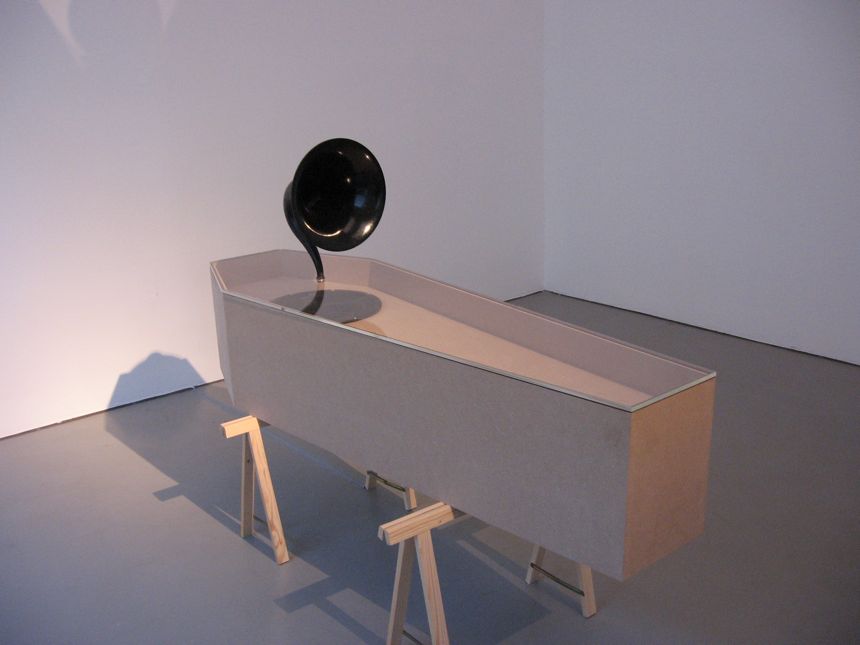
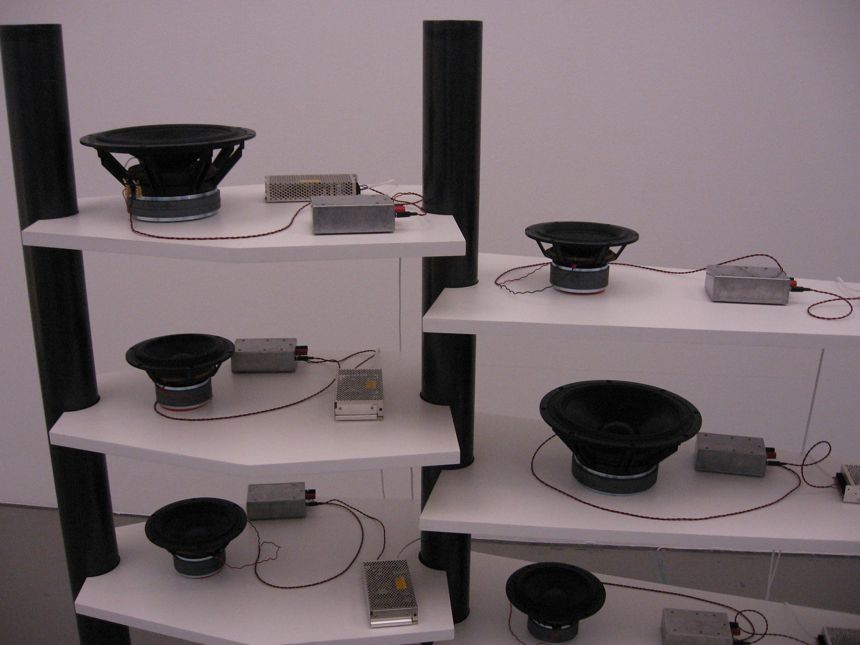
______
Dust (2009)
‘Images of the faces of missing children are projected piecemeal onto a surface covered with phosphorescent pigment powder. The image accumulates and the trace of faces is left behind as a green glow. Low frequency sounds vibrate the powder, transforming the image into abstract patterns of sound waves.
‘Everybody collects something. In 1987 I started collecting missing children flyers.
‘I don’t know whether it is just a local phenomenon, but in San Francisco there are mail advertisements featuring local automobile brake and clutch repair joints on one side, and on the other, images, usually a pair of images, of a child who has gone missing. The image on the left is a picture of the child at the time of disappearance, the image on the right is either an age-progression by an artist of what the child might look like now (often decades later) or a picture of the abductor, most frequently one of the child’s parents. Sometimes there is no picture on the right — probably the most worrisome case.
‘These cards are usually the first item of junk mail to throw out, but it was not contrariness that made me start collecting them. Rather, a project beckoned: I was immediately struck by the likeness between the two images — the child and the age-progressed child, or the child and the parent. The project would have been kinetic, media-archaeological, probably inspired by Christian Boltanski’s work from that period. Suffice it to say, some inner editor nixed the realization of that one. But I continue, to this day, to collect these most worthless items of junk mail, even as my own horizon of what constitutes surplus information has expanded.
‘Dust presents a fragment of this collection of likeness-pairs, scanned sequentially into the light-memory of phosphorescent powder. After a few minutes of exposure to the projected image, the powder retains a faint green image of the two faces on its surface, something akin to the »latent image« of photographic film or the veil of memory. Unlike photographic film, though, the image starts to distort. Propelled by low frequency sound vibrations, the powder starts to flow and dance, first distorting the faces and erasing their likeness, then distorting them into patterns* of abstract light in motion, with form and beauty all its own.
‘*These abstract patterns are known as »Chladni« patterns after the late 18th c. German physicist of that name. They were the first observed and studied images of sound, and their discovery attracted much attention, promising insight into the nature of vibration. Napoleon, the emperor of France, offered a prize to anyone who could rigorously explain the relationship between the visual patterns and the sound. The prize was claimed in the end, by the mathematician Sophie Germain, who determined that the patterns are in fact a consequence of the shape and material of the vibrating surface, rather than the frequency or spectral characteristics of the sound.’ — Paul DeMarinis
____________
Hypnica (2007)
‘A series of talking metronomes that use the voices of hypnotists to lull the listener into a sonic trance.’ — PDM
____________
Firebirds (2004)
‘Oracular flames kept captive within birdcages recite speeches of some politicians of the twentieth century. Gas flames, suitably modulated by electrical fields can be made to act as omnidirectional loudspeakers of surprising clarity and amplitude.’ — PDM
___________
The Messenger (1998)
‘In The Messenger, email messages received over the internet are displayed letter by letter on three alphabetic telegraph receivers: a large array of 26 talking washbasins, each intoning a letter of the alphabet in Spanish; a chorus line of 26 dancing skeletons and a series of 26 electrolytic jars with metal electrodes in the form of the letters A to Z that oscillate and bubble when electricity is passed through them.’ — turbulence.org
‘The Messenger is an internet-driven installation based on early proposals for the electrical telegraph, in particular those made by the Catalan scientist Francisco Salvo. As in many of my works I examine the metaphors encoded within technology, especially lost or orphaned technologies and try to trace their origins, speculating on the way that mechanisms are the repositories of larger unspoken conceptions and dreams. In The Messenger I take the telegraph as a point of departure from which to examine the relationship between electricity and democracy, and how electrical telecommunication technologies have participated in our solidarity and in our isolation, in our equality and our oppression, in the richness of our experience and the uncertainty of our lives.’ — Paul DeMarinis
_____________
Chaotic Jump Ropes (1995)
‘Bright vibrating cords and motors comprise a dynamic system that moves between order and chaos. Tracked by computers, these motions are translated into musical sounds, allowing interactive exploration of chaos as sight, sound and touch. Internet access provides online control of the chaotic systems.’ — PDM
______________
The Edison Effect (1993)
‘A series of interactive sculptures that play ancient phonograph records with laser beams. The reflections of light from the walls of the groove carry the audio information to photoelectric devices where it is translated first into an electrical signal, then into sound by a loudspeaker. The resultant sounds range from recognizable to distorted, something like a distant shortwave radio or a haunting bit of a melody just barely remembered. The arrangment of optics, motors and light allow random access to the grooves of the records, permitting distortion, dis-arrangement and de-composition of the musical material.
‘Each Edison Effect player is a meditation on some aspect of the relations among music, memory and the passage of time. Our sense of time, memory, and belonging have all been changed by the exact repetition implicit in mechanical recording. The needle in the groove, no less than the needle in the vein, is one symbolic emblem on our quixotic quest for the perfect moment of fulfillment. Re-played here, without needles, the record becomes what it really is: a holographic object, a simultaneous smorgasbord to be consumed in the order and taste we see fit. The raw and raucous noises of the record surface commingle with the sounds inscribed in the groove, creating a havoc of misinterpreted intentions and benign accidents.
‘The phonograph and the photograph have a coeval history of influence and development. The Edison Effect players demonstrate the photographic nature of acoustic recordings. These pinhole ( or needlepoint ? ) pictures of sounds long vanished project the shadows of sounds. Holograms, gamma rays, goldfish and cunieform serve to emphasize the parallel narrative of the mechanization of image and sonic inscription.’ — Paul DeMarinis
________________
The Edison Effect: Individual works
____________
‘Al & Mary Do the Waltz’
‘A turn-of-the-century Edison wax cylinder of Strauss’ “Blue Danube Waltz” is turned on a paint roller rotated by a motor and rubber band. A laser beam is focused on the groove of the cylinder and its reflections are translated into sound. The laser beam passes through a bowl of goldfish who occasionally interrupt the beam to produce uncomposed musical pauses.’ — PDM
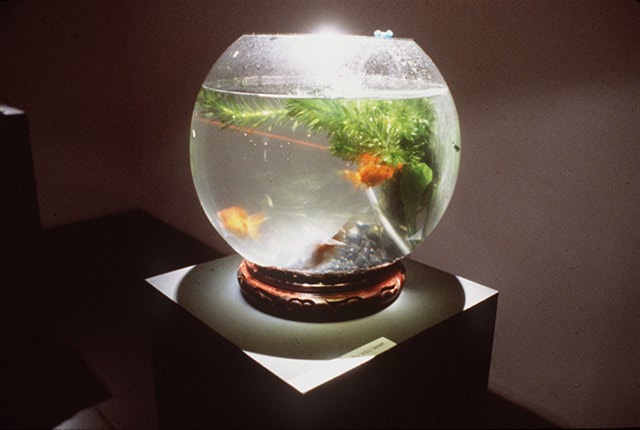
____________
‘Dinner at Ernies’

____________
‘Ich auch Berlin(er)’
‘A tribute to the Berlin(er) brothers, Emil, Irving, and John Fitzgerald. A gelatin dichromate hologram of a 78 rpm record of the “Beer Barrel Polka” is rotated on a transparent turntable and played by a green laser. Once I realized that only light reflections were needed to make the recorded grooves audible, it became apparent that a hologram (the memory of light reflecting from a surface) would suffice to play music. Here, sans needle, sans groove, the band plays on.’ — PDM
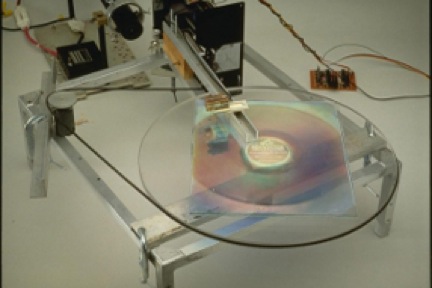
_____________
‘Lecture of Comrade Stalin’

_____________
‘Fragments from Jericho’
‘An authentic recreation of what is probably the world’s most ancient audio recording. A clay cylinder inscribed (by intention or accident?) with voices from the past. By gently turning a large black knob, you can direct the laser beam across the surface of the turning clay vessel to eavesdrop on vibrations from another age.’ — PDM

______________
‘Fireflies Alight on the Abacus of Al-Farabi’

_____________
‘Un-raveled Melody’
‘Mechanical recording exerted its effects upon music composition by coercing preexisting rondo forms into ever tighter spirals. A hologram of Ravel’s “”Bolero” cycles forever, as the laser beam weaves its path along the dance floor.’ — PDM

_____________
‘Murder by Television’
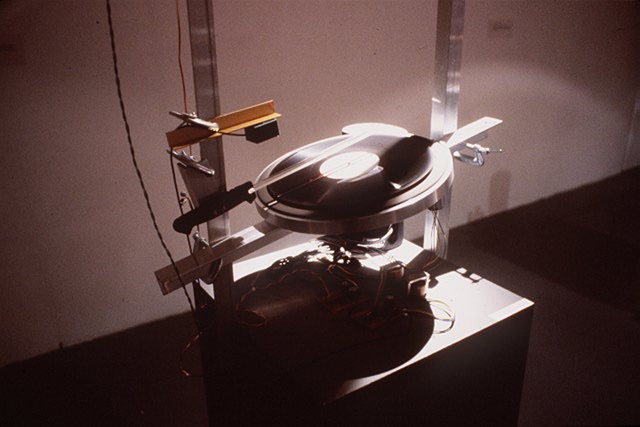
_____________
‘Rhondo in Blew a la Cold Turkey’
‘A 78 of “Rhapsody in Blue” is erratically scanned by a laser beam emitting from a hypodermic syringe. We may contemplate the addictive act of record listening as Oscar Levant plays himself playing Gershwin in another tired remake of “An American [Junkie] in Paris”.’ — PDM

____
Lecture
Essay in lieu of a Sonata
Paul DeMarinis
My title “The Edison Effect” has multiple references. It refers first to the profound and irreversible effect the invention of sound recording has had upon music, the soundscape, upon the time and place of our memory and sense of belonging. It should also call to mind Thomas Alva Edison’s illicit claim to the invention of the light bulb, and his general propensity for copying and appropriation as an emblem of the inherently uncertain authorship of all recorded works. Finally, it invokes a metaphorical allusion to the physical phenomenon known as the “Edison Effect” wherein atoms from a glowing filament are deposited on the inner surface of light bulbs causing them to darken. It was this phenomenon of thermionic emission that, when understood, made possible the invention of the “audion” or vacuum tube. This, in turn, led to the development of sound amplification as well as radio, television and the earliest digital computers. The metaphorical image of the darkening of the light is an ancient one, recurring in the I-Ching, in Mazdaism, and in Shakespeare’s oxymoronic “when night’s candles have burnt out”. Enantiodromic reversal at the atomic level can be used to symbolize opposing primal forces and may serve to mythicize otherwise commonplace occurrences.
Edison’s name and face are synonymous with invention, brilliance and technological innovation. As the modern Prometheus, he lured millions toward the light. The light bulb, commonly believed to be his consummate invention, still stands as an iconic exclamation of ideas, innovation – the stroke of genius.1 The discovery of a potentially fatal flaw inherent in the invention – that the light-producing bulbs would themselves darken, causing them to cast shadows rather than light – was perceived by Edison to be a potential bug, a stain upon his brilliant reputation. To compound the paradox with irony, this is the only bona fide scientific phenomenon which bears the inventor’s name. Whereas other nineteenth century colossi, such as Tesla, Ampere or Volta had basic units of measure or even third world nations named after them, Edison, universally resented by the scientific community and deemed by them a charlatan and promoter, was grudgingly awarded only this obscure and obscuring “effect” to immortalize his name.
It is often the case that a new medium’s first major flaw or contradiction is destined to become its dominant metaphor. The disembodying upside-downness of Della Porta’s camera obscura, the shadows created by light falling on Niepce’s photographic emulsion producing a “negative” image, the montage necessitated by the frailty and shortness of early celluloid film – these have become the mechanophors which convey the richness and complexity of our experience. No less with the whole of Edison’s oeuvre. Like the lightbulb, the phonograph casts its own unearthly shadows upon listening, upon our memory and our sense of time. It is the false and deceptive quality of the voice which emanates from the phonograph or gramophone, compounded by the mindless soliloquy of the of the broken record, which lends its root to our word “phony”. The exact repetition of this falsehood ingrains itself in our memories, creating a sequence of recognition, anticipation and fulfillment which is in itself addictive and predictive. Prior to the invention of mechanical recording, references to the now commonplace phenomenon of a tune-running-thru-the-head appear absent from literature.
A dream of early phonographers was to read with their eyes the wiggly line inscribed by the needle as a lasting trace upon the wax – allowing the illiterate to write, the uncouth to compose, even the spirits of the dead to speak. Such efforts soon proved futile.4 The scopic impulse relentlessly afoot in western civilization appears to have been delayed by almost an epoch. If the nineteenth century had invoked sight alone to comprehend the infinity of space, ( superseding the eighteenth century’s insistence that space is known by the sense of touch,) a more ancient tactile paradigm persisted in matters of memory, perhaps due to their traditional codings in the form of renaissance spatial-mnemonic systems. Until very recently – the 1980’s, – the memorative act of audition still consisted of dragging a diamond stylus, fingernail-like, across a vinyl blackboard. As the needle played, it eroded the memory it touched. Ever so slightly, as the needle touched, the sounds present in the room in which it played were minutely engraved and added to the record.
Edison’s earliest efforts were feeble impressions on tinfoil, easily erased by the act of playing them. Indeed, the first recording was so frail it only could reproduce once and then die. Later efforts in wax proved durable enough to be played dozens of times before the effects of the mechanism combined with the sounds in the environment would modify and erase them forever. And still each record was a unique object. The Edison laboratory’s earliest cylinders of mass production were created by capturing the sound of an orchestra on twenty or more phonographs – the orchestra’s output of a two minute waltz might thus amount to many hundred cylinders per day 5 . By the turn of the century, with the advent of electroplating and gold-molding, many thousands of records could be manufactured, sold, played, enjoyed and worn out before the orchestra would need to reconvene and intone the waltz anew. The escalation of this economic exercise culminates in the digital compact disc – a consumer item whose durability is adamantine and whose relation to the original soundwaves – thus its use-value – is determined wholly by the ruling taste. The laser touches but fleetingly upon the groove, the impact of its photons abrading no material whatsoever. The rupture is complete. The emancipation of memory from touch has been fulfilled. The age of the palimpsest is over.
_________
Further
Paul DeMarinis Webpage
CD: ‘The Edison Effect: A Listener’s Companion’
Paul DeMarinis @ Wikipedia
Video: Paul DeMarinis Profile @ Spark
Paul DeMarinis Artist Statement
Book: ‘Paul DeMarinis: Buried in Noise’
—-
*
p.s. Hey. Self-styled ‘devoted DC’s reader’ KD has put together a fine post about the fine sound artist Paul DeMarinis who happens to be one of her professors at Stanford University, so it’s kind of an inside job. Please peruse (and more) her post and give her a shout-out of some sort, thank you. And great thanks to you, KD! ** Bill, Thanks, Bill. The lag seems to be more merciful this morning. Well, skipping the festival to work on your own project is a gold star worthy bit of reasoning, so understood and congrats! Didn’t know they’ve reissued that Coil. Okey doke. Thanks! ** Kyler, Well … yeah, normalcy, what do I know about that. Jet lag logic and phrasing. The wrong tooth? Or … at least it was worthy. Unworthy? Anyway, I hope the painful one is soothed now. ** Jamie, G’morning back to you! You’re most welcome, thank you. The lag might, just might, no promises (to me) be already on its way to being inglorious history as of today, but the day after is always too soon to tell. ‘Magnificent Ambersons’ is sublime. Just know that the film was taken away from Welles, and the very ending, like the last five minutes or something, which are terrible, were shot by someone other than Welles and tacked on to give the film a ‘happy ending’. Other than that, I think it’s what genius is all about. Mm, well, I’ll know very shortly, but I think the possible co-producer is about getting someone on board to try to help get co-sponsors for the series, and I’m not sure how involved he’ll be with us. But, yes, it would be rather heavenly if he turns out to be a more reasonable person and can intervene. But she (our producer) chose him, so fuck knows. Oh, yes, the project with Hannah’s sister. Great! You’re on it! It doesn’t sound silly at all. Where are you in it? My today is that meeting shortly then some pre-London stuff I need to do, and, uh, … emails, I don’t know. What about yours? May your Wednesday cause a rope ladder to drop from the sun. Really realistic love, Dennis. ** Steve Erickson, I’ll skip the Rubin search then. Shorter is good(er), I think. Let me pass along your offer/request. Everyone, Steve Erickson has written the script of his new film, and he would love some feedback. It’s short, apparently. Would any of you be so kind and rewarded as to want to read Steve’s thing and get back to him? In his words … ‘If anyone wants to read it and offer me feedback, you can contact me at steveerickson123@hotmail.com. (I still can’t reliably read the comments on this blog, so if anyone posts about it here, I probably won’t be able to read it.)’ Thanks on Steve’s behalf. Also, before we leave the ‘Steve’ subject, he has reviewed Anna Calvi’s new album HUNTER here. ** _Black_Acrylic, Thanks, bud. Jetlag is down to about 1/2 strength, I think. God, that French film looks miserable. 89% of French films are kind of like that one and seemingly dreadful. I’m surprised that one got released outside of France because the vast, vast majority of French films never do for good reasons. ** Corey Heiferman, Hi, Corey. Glad you and Quinn got connected. Oh, yeah, Donald Meek is great. Let me see if I can get a decent post out of what’s available of his oeuvre. Thanks about ‘God Jr.’. Bon day! ** Misanthrope, G-ster. Good to see you too. Yeah, it was a bit of a busy NYC jaunt, it turned out, not unexpectedly, but it was nice to see you the little I did. I accidentally saw Ethan Hawke interviewed on TV yesterday, and he did seem like kind of an all right guy. Glad you had fun in the big N. Me too. Didn’t do a ton, though. Saw art. Did the Whitney reading thing, which was okay. Yeah, it was quick. Quadruple? Yikes, but with pay, so, yeah, congrats? ** Shane Christmass, Howdy. Thanks, thanks. ‘RiaGE’ is really strange. More strange than good, which is another kind of good. Uh, I don’t think most of those clips are online, so it’d be maybe impossible to do a post like that, I fear. I know the clip I star in isn’t online. I don’t think that film — ‘Man at Bath’ — got any kind of release or even showing outside of France. Great, thanks about the book! I’m peeled! ** Right. Be with KD’s post and Mr. DeMarinis’s music until I see you next, which will be, no surprise, tomorrow.




 Now available in North America
Now available in North America 
KD, thanks for this great post. I spent a happy hour this morning checking out the videos etc and feel like I’ve only scratched the surface. What a ton of ideas Demarinis seems to go through. Really great introduction for me, ta.
Dennis,
Glad to hear the jetlag seems to be diminishing.
How was the meeting? Is the co-producer promising? Shame he was chosen by the Pesky One.
Ta for the Magnificent Ambersons tip!
The webseries is atm a mass of notes, but quite a lot of notes with body. I’m currently trying to structure it as a series, say a projected 10 episodes of about 5 minutes each. I’ve said I’ll have the scripts done by the end of the year, which seems realistic, and I’ve done a first draft of two episodes, one of which is ok, the other being awful. Phew! We’re going to have a proper dedicated shoot too, next year on Skye.
When are you off to London?
How does Thursday look? I might be visiting a friend in hospital then getting a haircut. Hannah is going to see Daft Punk Orchestra, which is making me laugh as I can’t imagine a worse night out.
May Thursday tickle you in all the right places.
Dandiest of love,
Jamie
@ KD, you have an enviable teacher there. I love his Dust piece.
Seems there’s only one topic of conversation in this city right now. The Dundee V&A has welcomed the world’s media through the door, and today the museum posted this preview of its lavish interior. I must admit, it does look pretty impressive. There’s a whole bunch of online cheerleading all over my social media, I do wish the project well and hope it’s a success.
I remember after seeing LES INTOUCHABLES being shocked that the French film industry made films like that. Cheesy mainstream French comedies don’t usually get imported to American arthouses; the kind of bad French films that play here are generally neo-Tradition of Quality upscale historical dramas or literary adaptations. In fact, the Weinstein Company only bought the rights to LES INTOUCHABLES so they could do an American remake – which is now sitting in limbo for obvious reasons – but it wound up grossing $11 million in North America.
KD, Kudos. I rarely think of sound in the abstract and DeMarinis makes me do that, which, I think, is a good thing.
Dennis, I should’ve said yesterday that I’m fan of Mr. Buscemi. He can be downright sublime.
Yes, the Whitney thing. I’m a little embarrassed I knew nothing about it. Hahaha. I mean, I’m not that big a stalker/creeper. 😉 Somebody did say to me, “How do YOU not know about it?” I don’t know, I miss things. What can I say? I put the salt in the refrigerator the other night. I’m that kind of guy.
Well, quadruple the work with the same pay as I’m getting now. Not quadruple the pay. That’s okay. I’m paid well, even with this extra work. I’m not complaining one bit.
KD, thank you for putting this together. I really enjoyed Hypnica. I came across it right at a point in my morning when a 2-minute hypnosis was called for. Is the whole thing online somewhere? Also, is the voice of the hypnotist Robert Duncan by any chance? It sounded like him.
Dennis, what’s new? I hope you’ve recovered from jetlag and are back to your usual pursuits with full strength.
Hi KD, it’s an intriguing post, thank you so much for this. I should listen to some tonight. This town where I am at last feels autumnal and friendly to music.
Dennis, it was so good to see you and Zac, and, of course, the film blew my mind. I look forward to seeing it again in theater.
I’m a little too busy nowadays, but thinking of the film now and then calms me down. Talk to you soon. Good luck with the London events.
Hey KD,
Your teacher is a really fucking cool artist. Dust might give me nightmares for a while, I’m a good way. Thanks for sharing his work!!
Hey Dennis,
Ugh, jet-lag brain nearly erases any and all nostalgia I have for traveling.
So glad to hear the screening was so well received! I’m bummed I couldn’t make it out, now I’m just waiting for the physical/digital release.
I totally get what you mean by everything seems experimental when you’re a baby. I definitely feel like adjusting to form is basically the most interesting thing about art. I have to pause Celine for a while since I’m getting overloaded with homework, but a lot of it is reading shit like Baudelaire and Chekhov, so it’s hardly unwelcome.
Which I guess also answers the question of how the new schools treating me, which is a bit of a dream come true scenario. It’s not the easiest adjustment period, but I’m pretty blissed out over being obligated to read cool shit and talk about it with serious writers. Also, I got cast in the production of Three Sisters their doing here, so I’m still working on theater stuff, which is exciting. Yeah, definitely no regrets regarding this transfer so far.
Oh, right, I forgot that you’re an enemy of Google. I’ll try to convert the whole thing to a word document or something this week and send it your way.
How’s your week been?
again, jus wanted to say it was great to see permanent green light and your reading of wojnarowicz last week. also wanted to mention that we have a mutual friend in paul clinton whom i jus met irl this week, as we’ve been working on collaborating through my position at the leslie-lohman museum
Paul was my professor at Stanford when I was a grad student there. I liked him. Though I think the relationship soured a bit when is opening remark about my thesis paper was, “If didn’t have to read this whole thing for my job, I wouldn’t have gotten past the first page.” Good times.